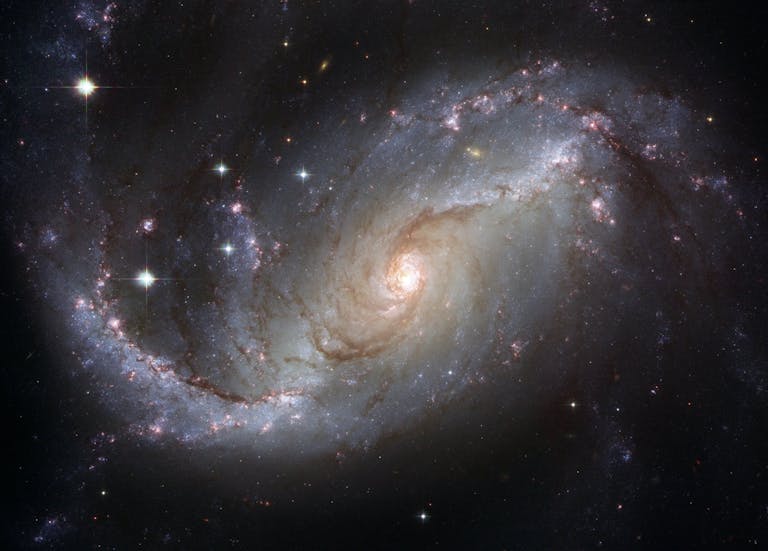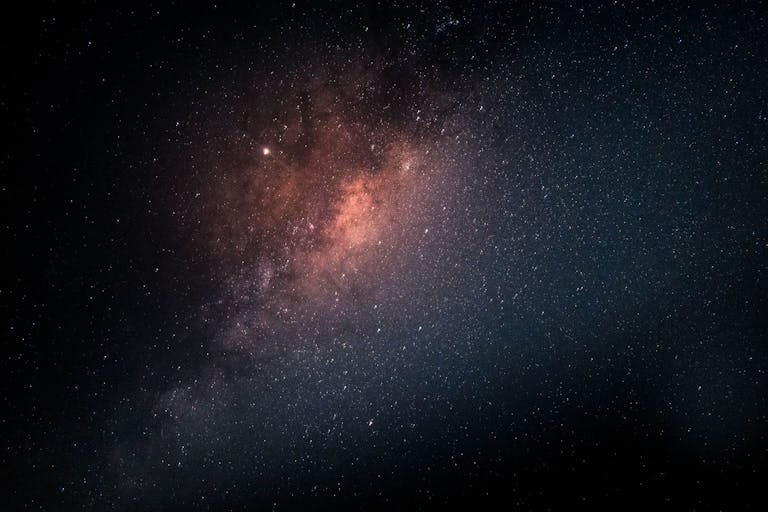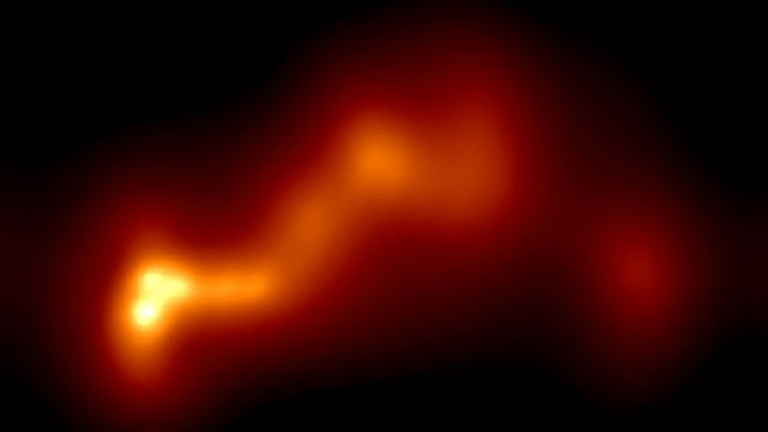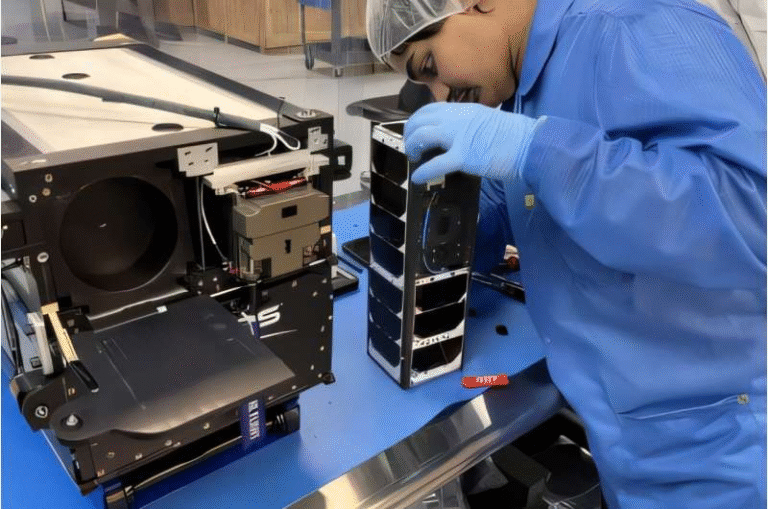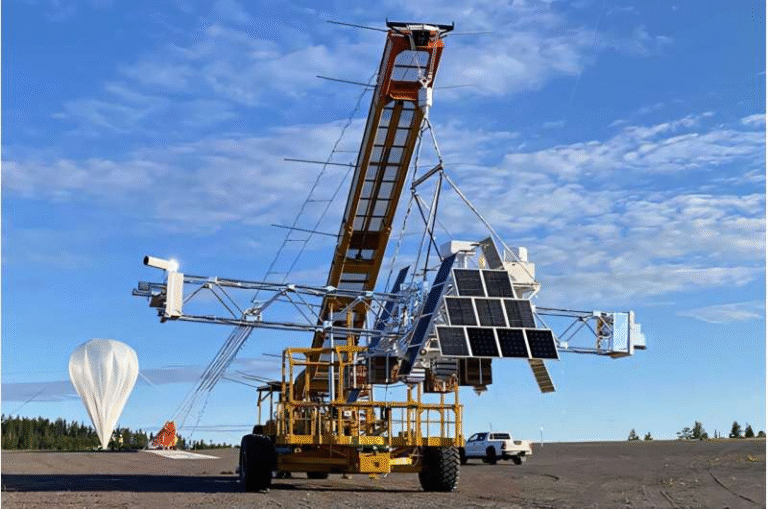Astronomers Find a Black Hole Growing Beyond Known Limits – A Cosmic Rule Breaker 12.8 Billion Light-Years Away

Astronomers have discovered something that doesn’t just bend the rules of physics — it seems to tear them up completely. A newly analyzed supermassive black hole, sitting inside a distant quasar named RACS J0320-35, is growing faster than scientists thought was even possible. This object, shining from a time when the universe was less than a billion years old, could help explain how some of the earliest and largest black holes came to exist so soon after the Big Bang.
The Basics: What’s Been Found
The black hole inside RACS J0320-35 is about a billion times the mass of our Sun and lies 12.8 billion light-years away from Earth. That distance means that the light we’re seeing left the quasar around 920 million years after the universe began, offering a direct look into the deep cosmic past.
This quasar is no faint object. It blazes brighter than entire galaxies, powered by an enormous disk of superheated material spiraling into the black hole. What makes this one extraordinary is how fast the black hole seems to be devouring that material. According to NASA’s Chandra X-ray Observatory, it’s growing at 2.4 times the Eddington limit, a threshold astrophysicists long believed no black hole could sustainably exceed.
Understanding the Eddington Limit
The Eddington limit is a kind of cosmic speed limit for growth. When matter falls toward a black hole, it heats up and releases enormous radiation. That outward pressure from light pushes against the infalling material. Eventually, the radiation pressure balances the gravitational pull, preventing any faster infall.
In simple terms: if a black hole eats faster than the Eddington limit allows, the radiation it produces should push new material away — effectively stopping the feast.
But RACS J0320-35 seems to have ignored this rule entirely. The Chandra data shows that it’s not just nibbling — it’s gulping down matter so rapidly that its mass could be increasing by 300 to 3,000 Suns every year. That’s like swallowing hundreds of stars annually.
How the Discovery Was Made
This black hole wasn’t found overnight. It was first spotted about two years ago through radio observations made by the Australian Square Kilometre Array Pathfinder (ASKAP). Scientists then followed up using the Dark Energy Camera in Chile and later with Gemini South Telescope on Cerro Pachón, which helped pin down its distance — confirming it existed less than a billion years after the Big Bang.
But the real breakthrough came with X-ray observations from NASA’s Chandra Observatory in 2023. The X-rays revealed that the black hole’s growth rate far exceeds the usual physical limits. The data matched models of “super-Eddington” accretion, suggesting that this quasar is genuinely expanding faster than theory says it should.
What “Super-Eddington” Growth Means
When scientists talk about “super-Eddington” accretion, they mean a black hole that’s growing faster than the radiation pressure should allow. It’s not just a minor violation of expectations — it implies that something unusual is happening in the accretion disk or surrounding structure.
There are a few ways this could occur:
- Anisotropic radiation – if the emitted radiation isn’t spread evenly in all directions, some material could still fall in faster.
- Thick accretion disks – instead of a thin flat disk, a puffed-up, doughnut-shaped disk could trap more radiation and keep feeding the black hole.
- Magnetic fields and winds – these could channel energy and material in complex ways, helping matter continue falling inward despite radiation pressure.
Whatever the mechanism, RACS J0320-35 shows that the early universe’s black holes may not have followed the slow, steady growth paths we once assumed.
Why This Discovery Matters
The early universe already poses a big mystery: how did black holes reach such enormous sizes so quickly? For decades, astronomers have struggled with this question.
If black holes always followed the Eddington limit, then to reach a billion solar masses in under a billion years, the first black hole “seeds” would have needed to start huge — maybe around 10,000 solar masses each. That’s much bigger than the remnants of the first stars, which were typically a few tens or hundreds of solar masses.
But if some black holes could temporarily grow faster than the limit, they wouldn’t need to start so massive. Even a modest-sized black hole born from a collapsing star could become a cosmic giant through sustained super-Eddington growth.
This discovery gives a real-world example of that possibility.
A Closer Look at the Numbers
Let’s unpack the details the researchers provided:
- Distance (redshift): z = 6.13 → 12.8 billion light-years away.
- Black hole mass: around 10⁹ times the Sun.
- Accretion rate: between 300 and 3,000 solar masses per year.
- Growth speed: 2.4 × the Eddington limit.
- Radio spectral index (αᵣ): 0.72 ± 0.02.
- Radio luminosity (L₁.₄): (5.8 ± 0.9) × 10²⁶ W/Hz.
- X-ray luminosity (rest frame 2–10 keV): ~1.8 × 10⁴⁶ erg/s.
The X-rays are unusually soft, meaning the emission is dominated by lower-energy photons. That’s important — it suggests the radiation isn’t coming from a jet pointed straight at us, but from the hot gas near the black hole itself. The research team compared this emission with theoretical models and found it matched what’s expected from a black hole accreting above the Eddington limit.
The Role of Quasars in the Early Universe
Quasars like RACS J0320-35 are some of the brightest and most energetic objects in the cosmos. They’re powered by accretion disks — rotating rings of gas and dust spiraling into a central black hole.
When the infalling material heats up, it emits intense light across multiple wavelengths — radio, optical, ultraviolet, and X-ray. This is why quasars can outshine entire galaxies even though they originate from a single compact region.
In the early universe, quasars are especially important. They serve as beacons from the cosmic dawn, revealing how galaxies and black holes evolved together. Observing them helps astronomers piece together when the first heavy elements formed, when the universe became transparent to light, and how structure began to take shape.
RACS J0320-35 adds an exciting new clue to that picture — showing that some early quasars may have been growing much faster than previously imagined.
The Mystery of the Jets
Interestingly, this quasar also shows signs of jets — narrow streams of particles shooting out from the poles of the black hole at nearly the speed of light. Jets are relatively rare in early quasars, and their exact formation process is still a mystery.
One idea is that the extreme growth rate itself could be helping to power the jets. When accretion is super-Eddington, strong magnetic fields and turbulent plasma could naturally lead to jet formation. If true, this would tie together two key phenomena: rapid black hole growth and relativistic outflows.
These jets could also play a role in shaping their galaxies, blasting away gas and influencing how future stars form — a process called feedback.
How Scientists Figured It All Out
The research combined data from several observatories:
- Chandra X-ray Observatory (NASA): revealed the unusually bright X-ray emission.
- Australian Square Kilometre Array Pathfinder (ASKAP): discovered the quasar via radio signals.
- Dark Energy Camera (at Cerro Tololo, Chile): provided optical confirmation.
- Gemini-South Telescope (on Cerro Pachón): measured its distance precisely.
- INAF-Brera Observatory (Italy): helped model the data and confirm the super-Eddington nature.
The study involved a large international team led by Luca Ighina from the Center for Astrophysics | Harvard & Smithsonian, with collaborators from Italy, Australia, Portugal, and other countries.
What This Means for the Bigger Picture
This discovery changes how scientists think about the formation of the first supermassive black holes. It hints that the universe’s earliest black holes might have had phases of rapid, nearly explosive growth, defying what we used to think were hard physical limits.
It also affects our understanding of galaxy formation, since these early quasars likely influenced their environments in dramatic ways. The energy they released could have heated nearby gas, triggered or halted star formation, and even affected reionization — the process that made the early universe transparent to light.
Finally, it shows why X-ray astronomy remains vital. Even when optical telescopes like the James Webb Space Telescope find faint, distant galaxies, X-ray observations can tell us what’s happening deep inside — where the most extreme physics unfolds.
The Road Ahead
Astronomers are now planning deeper and longer Chandra observations, combined with new data from JWST, to find more examples of super-Eddington quasars. The big question is whether RACS J0320-35 is a rare outlier or part of a broader population of fast-growing black holes that shaped the early cosmos.
If it’s the latter, the entire history of black hole evolution — from the first stars to modern galaxies — might need to be rewritten.
A Quick Primer: How Do Black Holes Form?
For readers who want a bit more context:
- Stellar-mass black holes form when massive stars collapse at the end of their lives.
- Intermediate black holes might form through collisions of smaller ones or dense star clusters.
- Supermassive black holes, like the one in RACS J0320-35, likely began as smaller seeds and grew by feeding on gas and merging with other black holes.
In the early universe, with dense gas and chaotic environments, growth could have been rapid — especially if super-Eddington accretion was more common than we thought.
Reference:
Luca Ighina et al., “X-Ray Investigation of Possible Super-Eddington Accretion in a Radio-loud Quasar at z = 6.13”, The Astrophysical Journal Letters (8 September 2025).
https://doi.org/10.3847/2041-8213/aded0a

